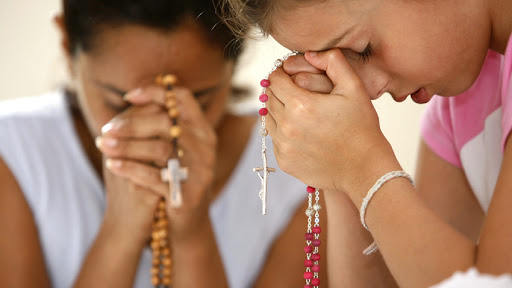In the 1950s, the “Rosary priest,” Fr. Patrick Peyton, championed the unity between the rosary and family life with his famous saying “the family that prays together stays together.” That was a long time ago, and it’s hard to imagine a major campaign of family rosary praying gaining the kind of traction that Fr. Peyton did so many decades ago. But there’s still a lot of truth to his words, and the rosary still matters a great deal to families.
But, you might say, children + the rosary = wailing and gnashing of teeth. How could we ever expect kids to pray the rosary?
Fair enough. And if the way we pray the rosary is to kneel and expect total silence, there’s a good chance that it would be a disaster when you add children, especially young ones, to the mix. But there’s a recently canonized saint, pope, and philosopher, who seemed to think it was an awfully good idea to at least try.
Of course I’m talking about St. John Paul II. He wrote a letter in the year 2002 on the rosary titled Rosarium Virginis Mariae.
More to read: The Rosary: Where it Came From and Why We Need it Now More than Ever
I find this letter to be one of the most beautiful things I’ve ever read by the Polish pontiff, and recommended it often when I worked in parish ministry. In the course of the letter, John Paul highlights some of his personal insights on how to pray the rosary, and the entire letter is a gem.
But his notes on the application of the rosary to the family are particularly illuminating. He says, for instance, that the prayer of the family rosary, while not a solution to every problem facing the modern world, can help to overcome some of the main vices of modern life. His fundamental concern is that families “seldom manage to come together, and the rare occasions when they do are often taken up with watching television.” However, if there is even an attempt to pray the rosary together, it will mean at the very least bringing the family together for something meaningful.
When a family gathers for the Rosary, John Paul II argues, it “means filling daily life with very different images, images of the mystery of salvation: the image of the Redeemer, the image of his most Blessed Mother. The family that recites the Rosary together reproduces something of the atmosphere of the household of Nazareth: its members place Jesus at the center, they share his joys and sorrows, they place their needs and their plans in his hands, they draw from him the hope and the strength to go on.” (RVM #41)
I love the comparison he draws! Many families spend hundreds of hours gathered in front of images that often involve violence, death, and an assortment of other vices. But the rosary brings different images to mind. It puts Christ at the center of the family, even if only for a short while, and helps us share in the experience of the family at Nazareth.
More to read: How Desperation and Devotion Can Change Your Prayer Life
John Paul II was keenly aware that many people think the rosary isn’t fit for children. But he challenges families to make it fit. Use symbols, use songs, make some sort of adaptation so that children can participate. And furthermore, he wants parents to challenge their children to live up to the task of a daily “pause for prayer.” He well knew that young people love living up to the call to a deeper faith.
In a small way, the rosary is a prayer that helps us to remember that great vocation of the Christian life.
And this is perhaps my favorite line from the document, the words he speaks to those who might doubt the usefulness of the family rosary: “Why not try it?” (RVM #42).
Here are some ideas to help if your kids are still young:
- Let the youngest child pronounce the word “Jesus” in every Hail Mary. John Paul II says the word “Jesus” is the “center of gravity” of the entire rosary and if the child learns only that word, they’re learning the most important part, and they’ll feel like they’re really a part of the prayer.
- Pray one decade every day of the week (Monday-Friday). It’s a much more manageable time frame and, by the end of the week, you’ve prayed a whole rosary!
- Have children who are old enough lead the prayers. Oftentimes, kids as young as 3 can have the Hail Mary memorized. The Our Father can be led by the oldest child because it’s longer and much more difficult to pronounce. Our five year-old still says “kemptation.”
- If attempting a full rosary, coloring pages for the kids that depict each of the mysteries are very helpful in keeping the kids from expending their energy in less productive ways, and still allows everyone the time together to pray and focus on Jesus.
- This may be the most useful tip: don’t force everyone to pray if the kids have had a long day, are in a bad mood, had too much sugar, etc. It’s probably not a productive enterprise for their spiritual life if you have to threaten them in order to get through the prayers. In those particularly difficult cases, get through what you can, and try again another day.

